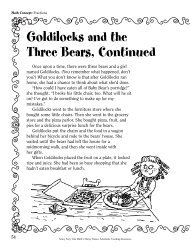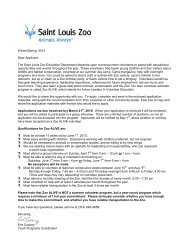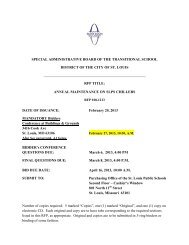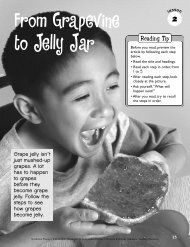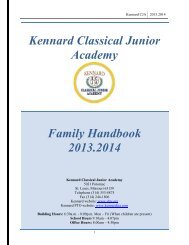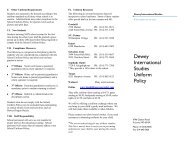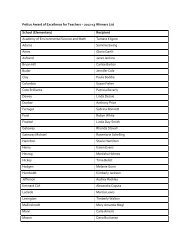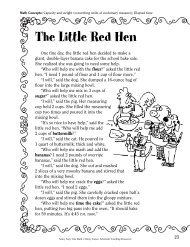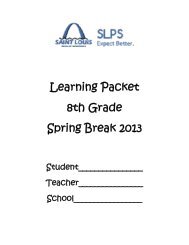Lab Writeâup Guide for IB Physics Always include the following ...
Lab Writeâup Guide for IB Physics Always include the following ...
Lab Writeâup Guide for IB Physics Always include the following ...
Create successful ePaper yourself
Turn your PDF publications into a flip-book with our unique Google optimized e-Paper software.
Processing raw data: You will manipulate your data through various calculations or graphing activities in most labs.<br />
Indicate how you did calculations by including at least one sample <strong>for</strong> each type. Graphs must <strong>include</strong> descriptive<br />
titles, units, be in proper scale and should be ei<strong>the</strong>r hand drawn or be from a graphing program as I indicate ahead<br />
of time. Usually <strong>the</strong> independent variable goes on <strong>the</strong> x axis. Only specific types of computer graphs are allowed and I<br />
will let you know when <strong>the</strong>y are appropriate. If you don’t know – DO ANY GRAPHS BY HAND ON PAPER! Suitable bestfit<br />
lines or curves are an essential way to show that uncertainties have been taken into account. Uncertainties in any<br />
data also need to be propagated through calculations.<br />
CONCLUSION AND EVALUATION<br />
a. Conclusion: Explain what <strong>the</strong> results tell you. What is <strong>the</strong> answer to your problem Restate <strong>the</strong> hypo<strong>the</strong>sis<br />
and compare your conclusion to it. How reliable are your results You must take into account any systematic or<br />
random errors and uncertainties. Do <strong>the</strong> data follow current scientific trends, or were <strong>the</strong>re errors that leave your<br />
conclusion questionable Evaluate and explain your results; this will lead straight into <strong>the</strong> evaluation, if you<br />
encountered many difficulties. Compare your results/values with <strong>the</strong> literature. Calculate <strong>the</strong> percentage difference<br />
between <strong>the</strong> measured value and <strong>the</strong> literature value. Use citations when you read o<strong>the</strong>r sources and <strong>include</strong>d <strong>the</strong>ir<br />
ideas.<br />
b. Evaluation: What weaknesses were <strong>the</strong>re in <strong>the</strong> design and method of your investigation How reliable and<br />
true are your data Were <strong>the</strong> measurements accurate (close to <strong>the</strong> true values) and precise (close to each o<strong>the</strong>r)<br />
Discuss any difficulties. The impact of errors and suggestions <strong>for</strong> improvement should also be <strong>include</strong>d. How could you<br />
have per<strong>for</strong>med this lab better<br />
What use is doing this lab and how might <strong>the</strong> data be used Are <strong>the</strong>re fur<strong>the</strong>r experiments that can be per<strong>for</strong>med or<br />
did <strong>the</strong> data suggest o<strong>the</strong>r avenues to explore What anomalies were <strong>the</strong>re and where were <strong>the</strong> errors How did those<br />
affect <strong>the</strong> data Use <strong>the</strong> <strong>following</strong> table to help you describe those errors and how to fix <strong>the</strong>m:<br />
The error or problem<br />
encountered<br />
Heat energy from <strong>the</strong><br />
reaction was lost to <strong>the</strong><br />
surroundings<br />
How that error affected <strong>the</strong><br />
data<br />
The maximum temperature<br />
recorded was lower than it<br />
should have been<br />
A suggestion <strong>for</strong><br />
improvement<br />
Insulate <strong>the</strong> reaction vessel;<br />
use a polystyrene cup + lid<br />
instead of a glass beaker<br />
Note: do not say “Measurements could have been more accurate…” or “<strong>the</strong>re was error in measurement.” Or “we<br />
could have worked harder/paid more attention.” Those are not valid evaluation statements and you are just wasting<br />
paper.<br />
Some things to avoid:<br />
‐ having a hypo<strong>the</strong>sis, procedure, & conclusion about different things. These 3 parts should be consistent<br />
‐ not recording data: if in doubt – record it. You should not <strong>include</strong> those values that are outliers.<br />
‐ taking too small a number of samples or trials. The more, <strong>the</strong> better.<br />
‐ recording data that did not occur.<br />
‐ beginning to work on <strong>the</strong> lab procedure and data table or <strong>the</strong> write‐up <strong>the</strong> day be<strong>for</strong>e it is due.<br />
‐ working too closely with your lab group. Even if <strong>the</strong>re is a suspicion of copying or use of same material,<br />
you will both noted has having committed malpractice and administration will be in<strong>for</strong>med.<br />
A checklist to make sure you have everything:<br />
· Are <strong>the</strong> independent and dependent variables clearly and correctly identified<br />
· Is <strong>the</strong> hypo<strong>the</strong>sis testable Is it suggesting an answer to <strong>the</strong> aim or question of <strong>the</strong> activity<br />
· Are <strong>the</strong>re appropriate strategies to control o<strong>the</strong>r variables that might affect your results<br />
· Is <strong>the</strong>re a clear easy‐to‐follow, step‐by‐step procedure outlined that someone else could follow<br />
· Does <strong>the</strong> experiment actually test whe<strong>the</strong>r <strong>the</strong> hypo<strong>the</strong>sis is supported or disproved<br />
· Have you got title and column units in your data table Included MOE in each column<br />
· Did you show how you did any calculations Included units in all equations and work<br />
· Did you use an appropriate system of data analysis (right sort of graph)<br />
· Did you propagate uncertainties through your calculations<br />
· Do your graphs have descriptive titles and units on <strong>the</strong> axis Did you draw a line of best‐fit<br />
· Does <strong>the</strong> conclusion accurately reflect <strong>the</strong> data<br />
· Are your procedural modifications fully and accurately discussed<br />
· Have you noted sources of error and how to fix those problems<br />
· Are anomalous results identified and explained in a reasonable manner



